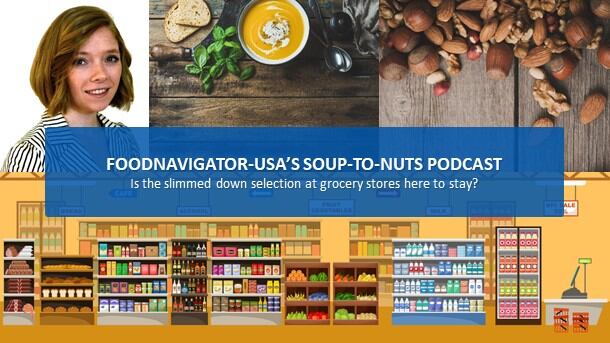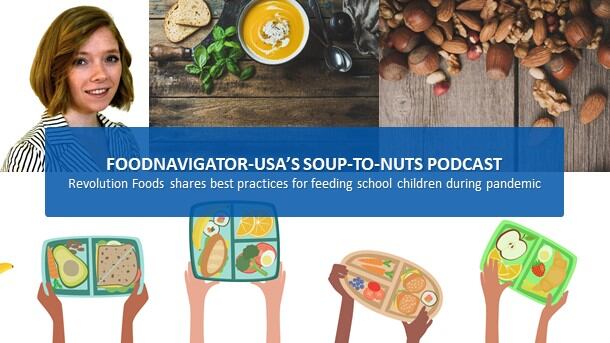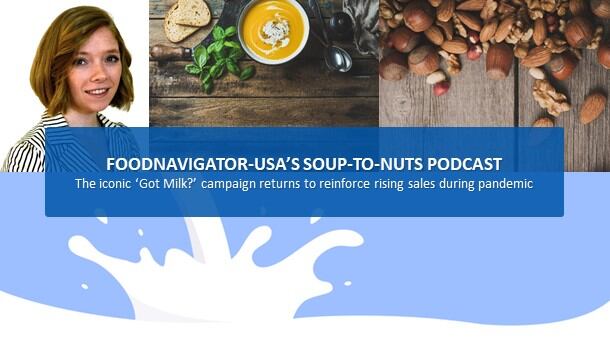According to recent research by the full service sales and marketing agency Acosta, 52% shoppers at the beginning of summer continued to notice fewer shelf-stable foods, 60% noticed less meat and seafood variety and 69% reported a fewer non-food products available on stores shelves. The disparity – and sparsity – of selection pre-and post-pandemic bothered 90% of shoppers and caused more than a third to feel anxious or stressed when they couldn’t find something that was always available pre-pandemic.
Shoppers aren’t the only ones thrown off by scaled-back offerings – retailers and manufacturers are too, according to David Gottlieb, managing director of the Americas at Trax, which provides computer vision and analytics solutions for retail.
He explains in this episode of FoodNavigator-USA’s Soup-To-Nuts podcast that the chaotic impact of the pandemic on supply chains, retailers’ warehouse management and ability to efficiently restock existing inventory, as well as shifting consumer demands created an “unintentional huge reset.” As a result, he says, the days of semi-annual resets and related SKU evaluation and rationalization are gone, and now stakeholders must continually evaluate product and partnership performance.
[Editor’s Note: Never miss another episode of FoodNavigator-USA’s Podcast – subscribe by clicking the button under the play icon above.]
“Before the pandemic, manufacturers worked with retailers and they generally reset the category twice a year – one major, one minor – and that’s when you saw some rationalization, some new items being introduced, space growing or shrinking for different brands. … The view we have today is that all this is happening unintentionally and at incredible scale kind of in the background,” Gottlieb said.
He added, “there’s a big risk that if manufacturers and retailers don’t really understand the state of the shelf, and don’t really understand what’s happening with all the metrics … they’re not in a very good position to chart the right path forward,” or make decisions about brand investments.
And this is where Trax shines – even amid the chaos of the pandemic. Gottlieb explains that through a combination of technology and a flexible labor model, Trax can help manufacturers and retailers understand why something is or isn’t selling and then optimize a product or store mix of maximum performance.
One way Trax does this is through its image recognition capability, in which teams photograph product at retail to track how it is merchandised and ultimately help brands and retailers present products the best way possible.
During the pandemic, Trax’s image recognition technology revealed several trends that Gottlieb said retailers and manufacturers need to consider when thinking through inventory levels and whether to add or axe a SKU. These include proof of the consumer shift to center store, preference for indulgent items and salty snacks, among others.
Deciding where to send limited inventory for the most impact
As manufacturers and retailers continue to shift their focus to better meet evolving consumer demands, many are still struggling with constrained supply lines – prompting at times tough decisions about how much product to send to each retailer.
Gottlieb says that Trax can also help manufacturers make this decision by providing them with extra transparency into retailers’ warehouses, inventory and stocking capabilities through its mobile workforce.
Gottlieb explained that this work force can go to stores and help pack out product from warehouses, restock shelves and apply instant redeemable coupons – tasks that retailers might have done in the past but with increased employee safety concernd don’t have the people power to do now.
While Trax can help reduce SKU rationalization by improving sales of available inventory, Gottlieb acknowledged that some SKU rationalization is due to lingering supply chain challenges – but he predicts many of those are category specific and ultimately will resolve themselves naturally as long as there isn’t another panic-fueled shopping surge.
An opportunity for emerging brands?
For now, ongoing SKU rationalization may be frustrating for consumers and worrisome for companies that have had to scale back selection to focus on high demand items, but Gottlieb said it has – a bit counterintuitively – created an opportunity for emerging brands to more easily secure shelf space in some instances.
He explained if a large brand scaled back half of its SKUs to focus on high demand items, those items might only need three-quarters of the company’s original space – freeing up room for smaller and emerging brands.
By rationalizing SKUs and facings of national brands, retailers also are making more space for local products, which Acosta’s research found are increasingly attractive to consumers. A survey conducted earlier this summer found that 24% of grocery shoppers are buying more US-made products and 17% are buying more local brands.
Among those buying more local brands, Acosta reports it is because 42% of shoppers want to support their local economy now. This could increase in the future with Acosta reporting that 69% of shoppers may consider buying more local brands post-pandemic.
Ultimately, there are a lot of moving pieces influencing the current flux of product mix available, which is why Gottlieb stressed it is even more important now than before the pandemic that manufacturers and retailers have real-time insights into what is happening at all levels, including consumer demand, retail availability and production capability.




